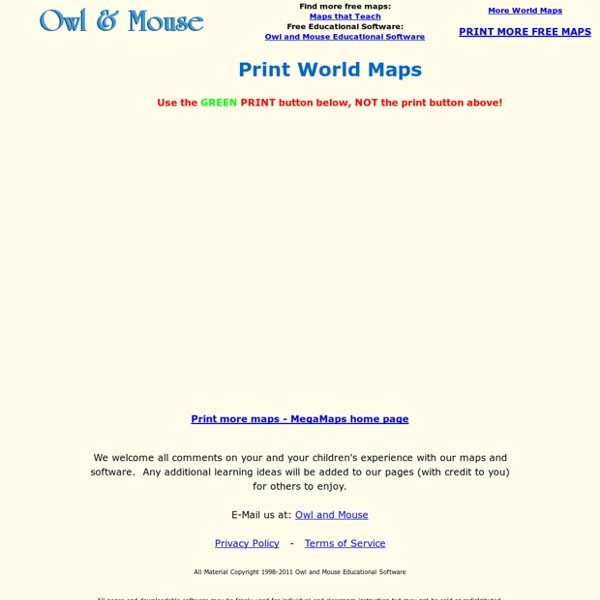



http://www.yourchildlearns.com/megamaps/print-world-maps.html
Related: So-ämnen • KartorPolitik & ideologier - hur styrs Sverige? - SO med Johanna Vi lever i samhällen där vi måste samarbeta och hålla samman på olika sätt för att få bra och väl fungerande samhällen. Det gäller så väl i samhällen nära oss, så kallade närsamhällen som t.ex. familjen, skolan och kommunen, som i mer avlägsna och större världssamhällen, som t.ex. EU eller FN. För att fatta beslut i frågor som berör många människor behövs politik. Maps Have Been Lying To You Your Entire Life The truth is that every map tells a lie, but they don’t all lie about the same thing. For example, Mercator projection maps—one of the most common in use today—exaggerate regions far from the equator. The Goode homolosine projection (pictured below) shows continents that are sized appropriately to one another, but with many interruptions and distortions of distance. Image Credit: Strebe / Wikimedia Commons This give-and-take of benefits has been a perennial problem in cartography. The issue is due to projection, which in map-making results from trying to turn a spherical globe into a flat plane.
Livsfrågor Svårt att hitta andlig vägledning Kyrkan fungerar i regel inte längre som vägledare i etiska frågor och kan av den orsaken inte heller svara på våra livsfrågor. De flesta av oss har därför inte några religiösa vägledande normer att falla tillbaka på utan måste istället hela tiden avgöra själva vad som är rätt och fel i olika situationer. The World’s Most-Spoken Languages In A Single Infographic This fascinating infographic elegantly breaks down the world’s most popular languages and the countries in which they are spoken. Specifically, the circle represents the 4.1 billion people around the world who speak one of 23 of the world’s most-spoken languages as their native tongue – the numbers of people speaking an actual language in any given country may actually be higher. It was created for the South China Morning Post by Alberto Lucas Lopez, an infographic journalist. Be sure to view the full-sized version to get all the details!
Klostrens organisation Tillbaka Munkklostren leddes av en abbot och nunneklostren av en abbedissa. Till sin hjälp hade de en prior respektive priorinna. En del av munkarna var prästvigda. De fick leda mässan, döpa, konfirmera, viga, ta emot bikt och begrava. Nunneklostren besöktes dagligen av prästvigda munkar eller predikarebröder (se "tiggarordnar") som förrättade mässan tillsammans med dem. This map of Earth is the most accurate ever produced, and it looks completely different Japanese architect Hajime Narukawa claims to have tackled a centuries-old problem - how to draw an oblate spheroid Earth on a flat plane. He claims the above map, called the AuthaGraph World Map, achieves this task. The projection, first created in 1999, frames the world's physical components in a 2D rectangle, attempting to represent their relative sizes as accurately as possible. It does so by dividing the world into 96 triangles, making it a tetrahedron, then unfolding it to become a rectangle. Unlike the traditional Mercator map, made in the 16th century, which overstates the size of northern areas like Greenland and minimizes that of central areas like Africa, the AuthaGraph World Map retains parity of area to a 3D projection. The projection recently won the 2016 good design grand award in Japan, an awards evening founded in 1957 by the Japanese ministry of international trade and industry.
Första världskriget – Mikaels Skola I arbetsområdet Första världskriget tar vi upp de bakomliggande orsakerna till att det utbryter ett världskrig, kopplat till 1800-talets och det tidiga 1900-talets imperialism, nationalism, industrialisering och allianssystem. Fokus ligger på utvecklingslinjerna. Varför uppstod ett krig? Hur förlöpte det och vad blev konsekvenserna? 40 maps that explain the world By Max Fisher By Max Fisher August 12, 2013 Maps can be a remarkably powerful tool for understanding the world and how it works, but they show only what you ask them to. So when we saw a post sweeping the Web titled "40 maps they didn't teach you in school," one of which happens to be a WorldViews original, I thought we might be able to contribute our own collection.
Förhandsvisa cirkel - Globalisering - Lärcirkelverktyget Allt vi gör påverkar människor, djur och natur runt om i världen! Idag finns det i princip inga samhällen som är helt isolerade från andra. Vi lever i en global värld där vi människor blir allt mer beroende av varandra. Saker som för bara några årtionden tillbaka uppfattades som exotiska, känns idag självklara. Man skulle nästan kunna säga att vi har världen i våra hem.
Tülays IKT-sida: Visualiserade kartor Visual Storytelling i skolan Projektet syftar till att på ett mer systematiskt sätt tillgängliggöra den kraft som visual storytelling och interaktiva statistikvisualiseringar kan skapa för elever och deras lärare. If it were my home Jämför Sverige med andra länder Mikaels Skola – Mikael Bruér – SO-lärare år 7-9 Bild och geografi – Kartor beskriver världen Genom undervisningen i ämnet geografi ska eleverna sammanfattningsvis ges förutsättningar att utveckla sin förmåga att: göra geografiska analyser av omvärlden och värdera resultaten med hjälp av kartor och andra geografiska källor, teorier, metoder och tekniker, Undervisningen i geografi ska behandla följande centrala innehåll I årskurs 4–6